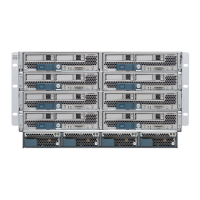3-10
Cisco UCS Invicta Scaling System Administration and Configuration Guide, Version 5.0.1.1a
Chapter 3 SSR Configuration
Prediction strengths of high, medium and low probability are based on the quantity of data points and
regression analysis validation. If enough data has been collected, the Storage Trend graph draws a
statistically valid regression line, for example, 30 days of data points yields a prediction probability with
a high strength.
Trend calculations without sufficient or with inconsistent data points will be calculated, but can be
statistically weaker or inconclusive. If a calculation cannot be made based on the data points, a message
appears to indicate this status.
Physical Space Alerts
The status of physical space is monitored on an hourly basis. Alerts are triggered at the capacities and
frequencies listed in Table 3-3. These messages can be viewed from the SSR Configuration menu under
Alert Admin. Alerts are also sent to Autosupport and to the additional addresses provided in the
Autosupport CC field on the Support Settings window. For information on alerts and how to suppress
them, see See “Uninstall Update” on page 14.
iSCSI Settings
The iSCSI Screen Lists the IP addresses by which an Initiator (a host) is allowed to access the Cisco
UCS Invicta Scaling System SSR.The two columns represented in the window are:
• Allowed Portal: Lists IP addresses to which a host is allowed to connect.
• Available Portal: Lists all available IP addresses of hosts that can used to initiate a session.
Changing Initiator IP Address Availability
Step 1 Choose SSR Configuration > iSCSI Settings.
The iSCSI Information window appears.
Step 2 Use the drag-and-drop functionality to move an Initiator to or from the Available and the Allowed Portal
IP addresses columns.
Note If the Allowed Portals column is empty, there are no restrictions for access and all IPs listed in the
Available column can be used for iSCSI communication
Table 3-3 Capacity Alerts
Percent Full Frequency Sent
70 Once
80 Once
85 Once per hour

